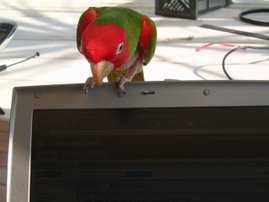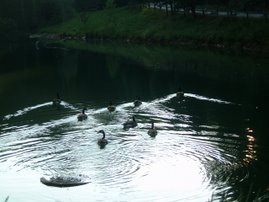Our pretty cherry-head (red-masked) conure can scream with the best of them. If you have every met one, you know what I mean. In fact, the literature about this species always talks about how loud they are. However, I have found that he is no different than any toddler that wants something but can't express her/himself in "human" language. But, lucky for him, I can talk with birds. And, so can you.
First you will take notice of the screaming details: Where exactly is the bird when it occurs - and I do mean "exactly". Is he in a specific spot on his perch, cage, etc.? Where exactly is everyone and anyone else in the home? What is going on in the home (music playing, TV on, kids around, someone talking on the phone, water running (where), food cooking (what kind), lighting, etc. Seriously, if you want to figure this out and find a calm and quiet way to live in joyous harmony with your screamer, then start a journal. Do this for a full week and include as much detail as you are willing to manage. Include details about what physical activity for the bird preceded and followed the screaming episode. Then come back to www.talkingwithbirds.blogspot.com to read "Screaming Bird Help - Part Two". We will discuss the patterns that may be emerging from your screaming journal.
Our pretty little parrot has devised his own way to train and control us by the way he uses screaming, among several other activities. Through my observations and conversations with him, I have been able to build some balance, peace, and fun in to our communal living situation (human-bird).
Our precious feathered friend has been with us for nearly 30 years. So if you plan a long and happy relationship with a bird that screams a lot, this is a very worthwhile task to take on.
Tuesday, May 10, 2011
Saturday, May 7, 2011
H2O ~ WATER ~ AGUA
Your bird relies on you to provide all the resources he or she needs for life. Like humans and most other creatures, your bird needs fresh water. There are two schools of thought about water straight from the tap vs. using filtered or bottled water. If your water comes from a municipal water supplier, then you are probably aware that it will likely contain certain chemicals at or below levels set by the government for clean and safe water. One of those chemicals is often chlorine. Chlorine could be beneficial as a way to prevent bacteria from forming in your bird's mostly stagnant water dish. A bird's water can easily become tainted when he or she drops food or toys or poop in the dish. This is especially true if your bird uses this same water dish for bathing. That is why some veterinarians recommend using this processing, chlorinated water which keeps bacteria at bay longer than spring or filtered type of water. For those that have a strong preference to supply your bird with spring or filtered water, it is recommended that you change the water at least two times per day; more often if you see the water is soiled with debris of any sort, even a piece of fresh vegetable.
Water is your bird's lifeline. Keep it fresh and safe. Your bird will love you for it.
Subscribe to:
Posts (Atom)



